Do Young Cardinals Have Black Beaks?
Young cardinals initially display black or dark beaks, which serve purposes like UV protection and camouflage. This dark coloration is due to higher melanin concentrations in the beak's keratinized tissue.
As they mature, their beak color evolves to vibrant reds, driven by hormonal changes and dietary intake of carotenoids. This transformation not only signals readiness for breeding but also reflects their health status.
Observing these changes provides valuable insights into cardinal development and maturation processes. Explore further to uncover the intricate factors influencing these fascinating color shifts.
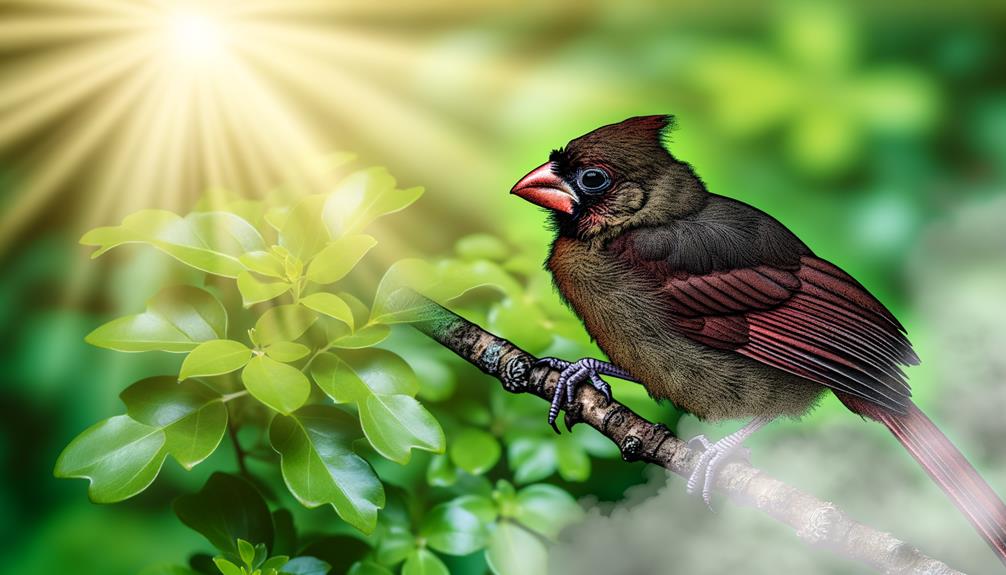
Key Takeaways
- Young cardinals initially have dark-colored beaks for UV protection and camouflage.
- The beak color changes from dark hues to vibrant reds as they mature.
- This transformation involves a shift in pigment concentrations from melanin to carotenoids.
- Observing beak color evolution provides insights into cardinal development and life stages.
- Environmental and physiological factors influence the timing and rate of beak color change.
Cardinal Species Overview
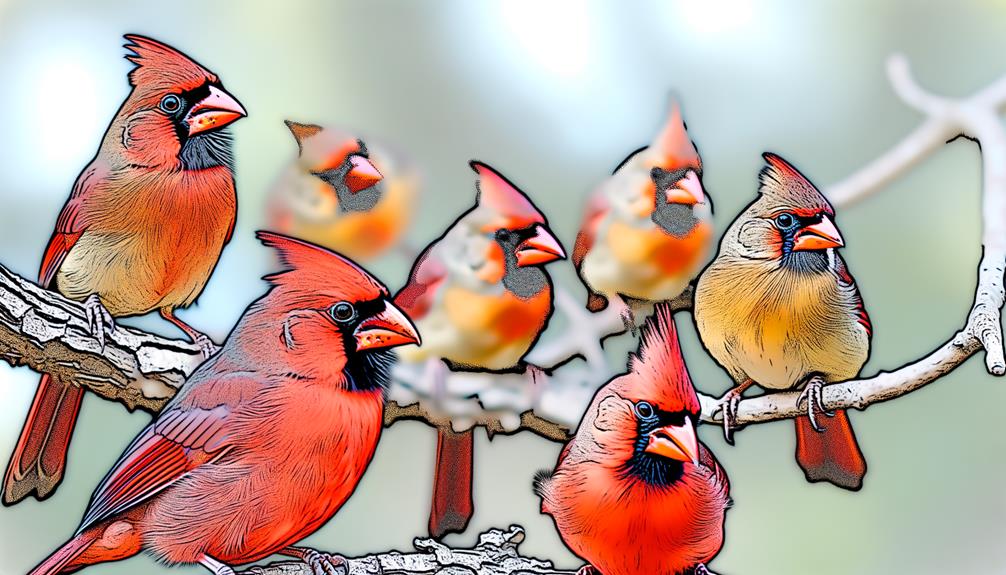
Cardinals, belonging to the family Cardinalidae, encompass a diverse array of species known for their vibrant plumage and distinctive songs. Mainly found across the Americas, these passerine birds exhibit sexual dimorphism, with males typically boasting more vivid coloration compared to females.
The Northern Cardinal (Cardinalis cardinalis), one of the most widely recognized species, showcases a striking red hue in males and a more subdued, brownish tone in females. Additionally, cardinal species like the Pyrrhuloxia (Cardinalis sinuatus) and the Vermilion Cardinal (Cardinalis phoeniceus) contribute to the family's rich biodiversity. Their habitats range from woodlands to gardens, indicating their adaptability.
Analyzing their morphology reveals notable features such as robust, conical beaks designed for seed consumption and strong, melodic vocalizations used in communication and mating rituals.
Cardinal Life Cycle
The life cycle of the cardinal begins with the egg stage, where incubation typically lasts 11 to 13 days.
Upon hatching, the altricial young are entirely dependent on parental care, marking the start of critical juvenile development stages.
These stages encompass significant physiological and behavioral changes, preparing the young cardinals for eventual independence and reproductive maturity.
Egg to Hatchling
From the moment a female cardinal lays her speckled eggs, a meticulous and fascinating process of development begins within the protective confines of the nest. The incubation period, lasting approximately 11-13 days, is vital for embryonic growth. During this time, the female mainly incubates the eggs while the male provides food.
Inside the egg, cellular division and differentiation occur rapidly, forming the essential structures of the bird. By the end of the incubation period, the embryo has developed into a hatchling, ready to break free from the egg. The hatchling emerges altricial, meaning it is born blind, featherless, and entirely reliant on parental care for warmth and nourishment, marking the start of its journey towards fledging.
Juvenile Development Stages
Upon hatching, the altricial young start on a rapid growth phase characterized by significant physiological and behavioral changes that prepare them for independence. Initially, they exhibit a black beak, which is a key feature for identifying juvenile cardinals.
During the first few weeks, their parents provide constant feeding, ensuring proper nutrition essential for their development. Feather growth begins, evolving from sparse down to a more developed plumage. Behavioral changes include improved motor skills, such as hopping and fluttering, essential for fledging.
Egg to Hatchling

Each cardinal egg undergoes a meticulously timed incubation period of approximately 11 to 13 days, during which key developmental processes occur. During this period, the embryo progresses through various stages of growth, beginning with the formation of essential organs and systems. Nutrients provided by the yolk sac facilitate the differentiation of cells into specialized tissues.
By the end of the incubation period, the developing bird has formed necessary anatomical structures, including its initial plumage and beak. The mother's consistent warmth and protection are vital for maintaining the egg's best temperature, ensuring successful embryonic development.
Upon hatching, the chick emerges, equipped with the necessary physiological features to begin its life outside the egg.
Beak Color at Birth
At birth, young cardinals display beaks that are characteristically dark in color, a stark contrast to the bright red beaks they develop as adults. This early pigmentation is significant for several reasons, including camouflage and development. The dark coloration can be attributed to higher concentrations of melanin, which serves multiple biological functions.
- Melanin Distribution: The dark pigment provides some degree of protection from ultraviolet (UV) radiation.
- Camouflage: The dark beak blends with the nest environment, reducing predation risk.
- Developmental Markers: The beak color indicates early nutritional status and overall health.
- Evolutionary Advantage: This trait may have evolved to increase the likelihood of survival in the vulnerable hatchling stage.
Understanding these aspects offers valuable insight into avian growth and development.
Juvenile Cardinal Traits
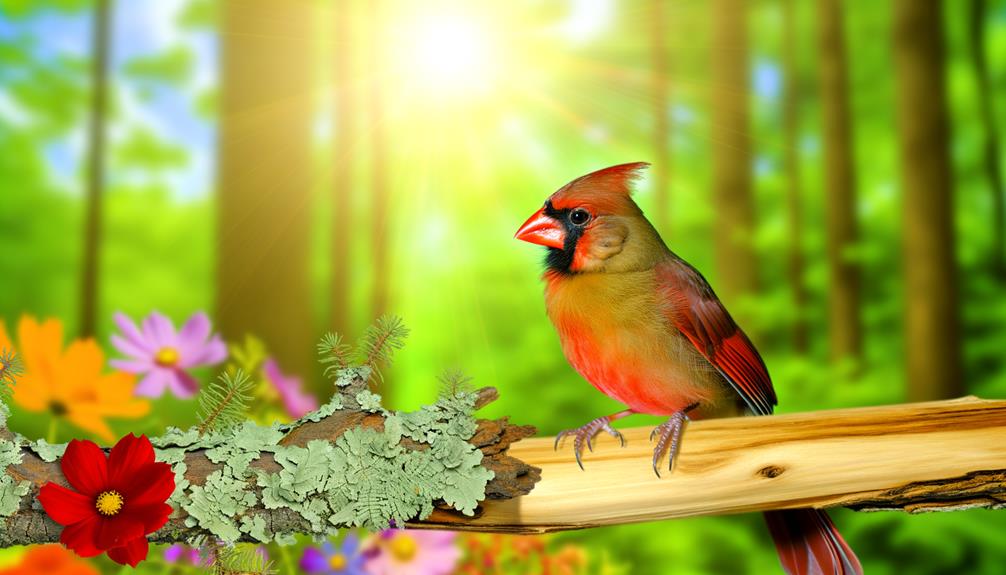
Juvenile cardinals exhibit distinct characteristics that differentiate them from their adult counterparts, particularly in plumage color variations and beak color changes.
During the early stages of development, their feathers often display a more muted palette, while their beaks shift from black to a more vibrant hue as they mature.
Additionally, behavioral differences in feeding and social interactions can be observed, providing essential insights into their growth and adaptation processes.
Plumage Color Variations
The plumage of juvenile cardinals exhibits significant variation in color, ranging from muted browns and grays to hints of the vibrant red that characterizes adult males. These color variations are influenced by several factors including genetic makeup and environmental conditions. Juvenile cardinals are generally less vivid, which plays a role in camouflage and survival.
- Initial Browns and Grays: Juveniles typically start with earthy tones that provide effective concealment.
- Emerging Reds: As they mature, small patches of red begin to appear, particularly in males.
- Feather Texture: Juvenile feathers are often softer and less structured compared to adults.
- Sexual Dimorphism: Males progressively show more red, while females retain more subdued hues.
Understanding these variations helps in identifying and studying juvenile cardinals accurately.
Beak Color Changes
Shifting from the muted tones of their initial plumage, young cardinals exhibit a notable alteration in beak coloration, evolving from dark gray or black to the bright orange-red characteristic of adults. This metamorphosis typically occurs as the juvenile matures, generally within the first year.
The dark pigmentation in juvenile beaks is attributed to higher melanin concentration, serving potentially as camouflage. As the bird ages, the melanin decreases, and carotenoid pigments, derived from their diet, become more prominent, resulting in the vibrant adult coloration. This change is not merely cosmetic but also indicative of the bird's health and readiness for breeding.
Detailed observations suggest that this transformation is a gradual process, aligning with the overall development of the cardinal.
Behavioral Differences
Young cardinals exhibit distinct behavioral traits that set them apart from their adult counterparts, providing valuable insights into their developmental stages and social interactions. Juvenile cardinals demonstrate several key differences in behavior that are observable and measurable, allowing ornithologists to understand their growth and adaptation better.
- Feeding Habits: Juveniles are often reliant on parents for sustenance, frequently engaging in begging behaviors such as fluttering wings and vocalizations.
- Social Interaction: They tend to form loose flocks with other juveniles, which aids in social learning and predator avoidance.
- Flight Proficiency: Young cardinals show less adeptness at flight initially, often practicing short hops and flights to build strength and coordination.
- Territorial Behavior: Unlike adults, juveniles are less territorial, often tolerating close proximity with other birds.
These behaviors are critical for juvenile survival and eventual progression to adulthood.
Why Beak Color Changes
Beak color changes in young cardinals are primarily influenced by physiological and environmental factors. These factors include diet, genetics, and hormonal levels. As cardinals mature, hormonal fluctuations – particularly in sex hormones like testosterone – trigger the deposition of pigments such as carotenoids and melanins in the beak's keratinized tissue.
Genetic predispositions also play a pivotal role in determining the baseline pigment production and distribution. Environmental conditions, including exposure to sunlight, can further modulate these pigments, affecting the intensity and hue of the beak color. Additionally, the bird's overall health and metabolic rate influence the efficiency of pigment synthesis and deposition.
Together, these factors culminate in the shift from the black beaks seen in juveniles to the vibrant hues characteristic of mature cardinals.
Diet and Beak Development
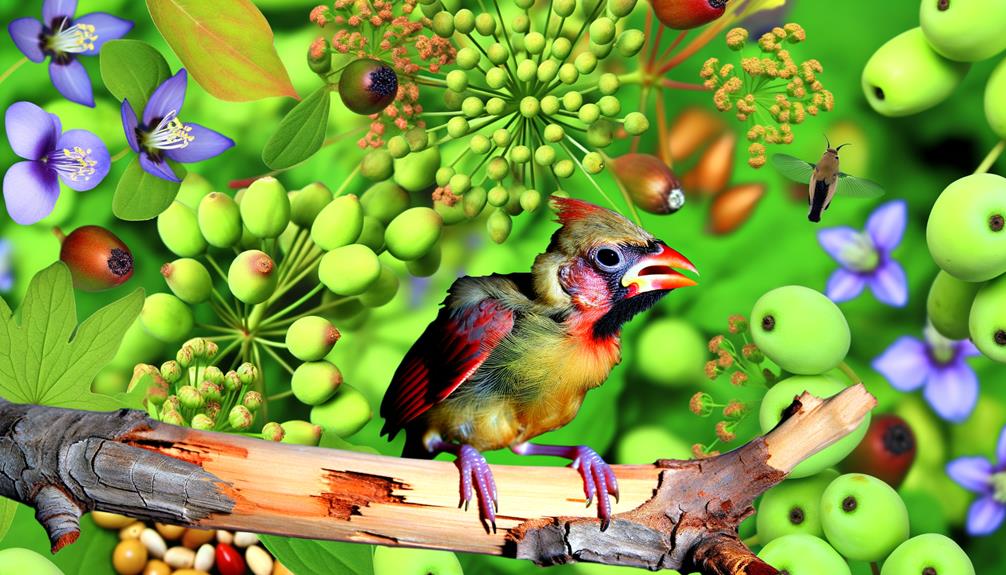
The role of diet in beak development is significant, as the availability and intake of specific nutrients directly influence the pigmentation and structural integrity of the beak in young cardinals. Nutrients such as carotenoids, calcium, and proteins are essential for proper beak formation and coloration.
Carotenoids, found in fruits and seeds, contribute to the red pigmentation seen in adult cardinals. Calcium is vital for the hardness and durability of the beak, while proteins are necessary for overall growth.
- Carotenoids: Enhance pigmentation, aiding in the shift from black to red beaks.
- Calcium: Vital for strengthening the beak structure.
- Proteins: Support growth and development of beak tissues.
Diet diversity: Ensures a balanced intake of necessary nutrients for ideal beak health.
Understanding these dietary components is essential for comprehending beak development in young cardinals.
Environmental Influences
Environmental factors play a critical role in shaping the beak development and pigmentation of young cardinals. Variation in ambient temperature, humidity, and exposure to sunlight can greatly influence the biochemical pathways responsible for melanin synthesis in cardinal beaks.
For instance, higher UV exposure has been documented to boost melanin production, potentially contributing to darker beak pigmentation. Additionally, pollutants and toxins present in the environment may disrupt normal pigmentation processes, leading to aberrant coloration.
Seasonal changes also affect food availability, indirectly influencing the nutritional status of young cardinals and thereby impacting beak color. Understanding these environmental influences is essential for elucidating the complex interplay between genetics and external factors in determining beak characteristics in cardinals.
Beak Color in Adolescents
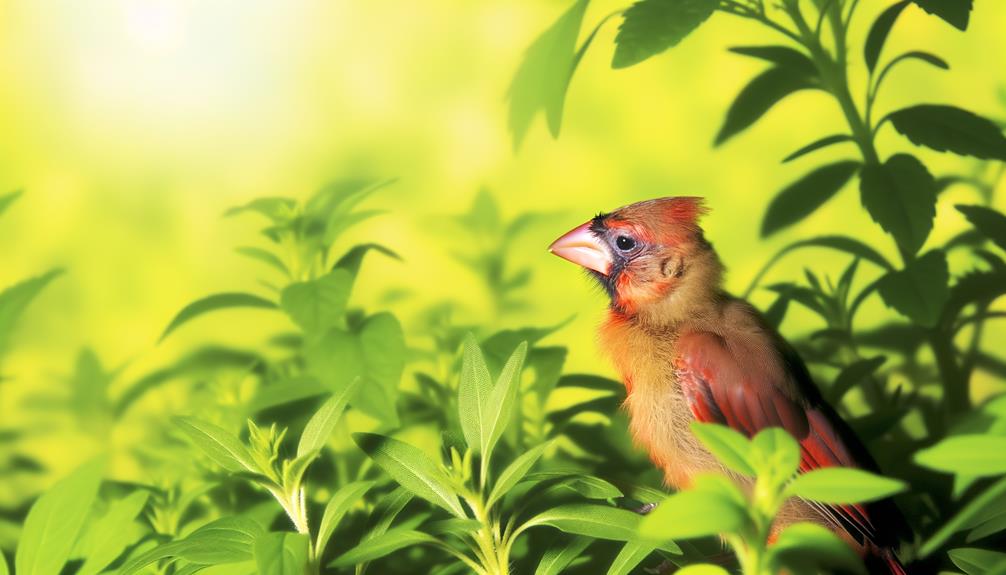
During the adolescent phase, cardinal beak pigmentation undergoes significant alterations, influenced by a combination of genetic factors and environmental conditions. As young cardinals progress from fledglings to mature adults, their beaks, initially dark or black, begin to lighten and adopt the bright orange-red hue characteristic of adult cardinals.
This transformation is a complex interplay of melanin reduction and carotenoid intake, essential for achieving the vibrant coloration.
Key factors influencing beak color changes in adolescent cardinals include:
- Dietary intake: Carotenoid-rich foods enhance red pigmentation.
- Genetic predisposition: Specific genes regulate the rate and pattern of color change.
- Hormonal shifts: Hormones like testosterone influence pigmentation.
- Seasonal variations: Environmental factors such as light exposure affect melanin and carotenoid absorption.
Understanding these dynamics provides insight into the developmental biology of cardinals.
Signs of Maturity
As young cardinals mature into adulthood, significant physiological and behavioral changes become evident. One primary indicator is the gradual shift in beak coloration from black to a bright orange-red hue, signaling sexual maturity and readiness for reproduction.
Concurrently, behavioral alterations such as increased territoriality and courtship activities are observed, reflecting the bird's developmental progress towards adulthood.
Color Change Indicators
The progression of color change in young cardinals, especially the shift from black beaks to brighter hues, serves as a critical indicator of their maturation and readiness for adult behaviors. This transformation is methodical and reflective of physiological changes within the bird. The beak's coloration is influenced by hormonal shifts and dietary intake, which together mark the shift from juvenile to adult stages.
Indicators of beak color change include:
- Initial Stage: Beaks are mainly black, indicating juvenile status.
- Intermediate Stage: Gradual lightening of the beak, often resulting in a mixed coloration.
- Late Stage: Emergence of orange tones, signifying nearing maturity.
- Final Stage: Fully bright orange or red beak, denoting complete maturation and sexual readiness.
Such changes are essential for the bird's development and subsequent reproductive success.
Behavioral Shifts Observed
In conjunction with the physiological changes indicated by beak coloration, young cardinals exhibit distinct behavioral shifts that signal their progression towards maturity. Juvenile cardinals, initially dependent on parental care, gradually display increased autonomy. This independence is marked by more frequent foraging and exploratory behaviors, indicating a reduction in reliance on parental feeding.
Additionally, maturing cardinals begin to exhibit territorial behaviors, such as vocalizations and defensive posturing, essential for establishing breeding territories. Social interactions also evolve; fledglings participate in communal roosting and flock dynamics before eventually seeking solitary or paired interactions typical of adult cardinals.
These behavioral adaptations are vital for survival and successful reproduction, underscoring the complex interplay between physiological and behavioral development in cardinal maturation.
Comparing Adult and Young Beaks
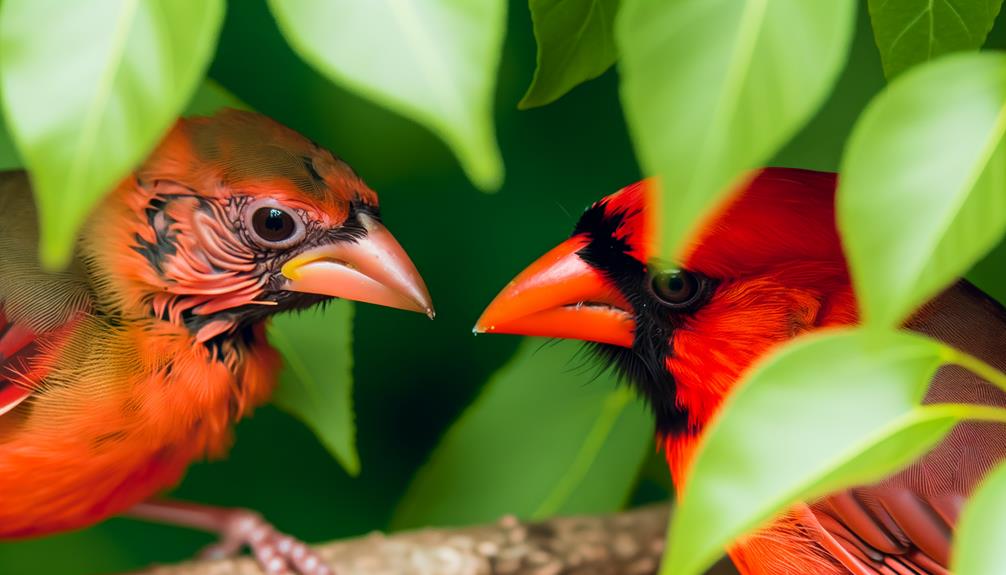
Why do young cardinals exhibit a striking difference in beak coloration compared to their adult counterparts? This variation in beak color is primarily due to developmental and physiological changes as the birds mature.
Young cardinals typically have darker, almost black beaks, which gradually shift to the iconic bright orange-red hue seen in adults. This transformation can be attributed to several factors:
- Pigmentation Changes: Increased carotenoid accumulation in the beak tissues.
- Hormonal Influences: Hormonal shifts during maturation affecting pigmentation.
- Dietary Intake: Differences in diet that influence carotenoid levels.
- Genetic Regulation: Genetic factors that control the timing and degree of color change.
These elements collectively contribute to the observable differences between the beak colors of juvenile and adult cardinals.
Conclusion
The beak color of young cardinals undergoes significant transformations throughout their development, influenced by both genetic and environmental factors. At birth, hatchlings typically exhibit dark, often black beaks, which gradually lighten as they mature into juveniles.
What causes this shift in pigmentation? As cardinals progress to adulthood, their beak color stabilizes into the characteristic bright orange-red seen in mature individuals.
Understanding these changes not only provides insights into cardinal biology but also enhances knowledge of avian developmental processes.






